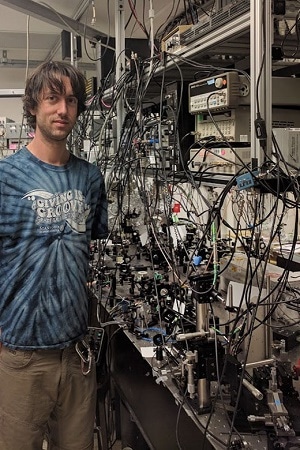Sep 28 2016
 Stanford graduate student Brannon Klopfer helped develop the multi-pass microscope described in the current edition of “Nature Communications.” (Image credit: Thomas Juffmann)
Stanford graduate student Brannon Klopfer helped develop the multi-pass microscope described in the current edition of “Nature Communications.” (Image credit: Thomas Juffmann)
Photos captured in poorly lit places such as restaurant or a concert venue turn out to be grainy and fuzzy. This issue is faced by researchers who want to capture images of biological specimens and have to work in low light areas in order to avoid damaging fragile samples. The resulting grainy images make it hard to clearly see the internal structures and intricate proteins they are trying to analyze.
Grainy images are caused by a concept referred to as shot noise. A team of researchers at Stanford may possibly have an elegant solution to this issue, which they call “multi-pass microscopy.”
This method is illustrated in the September 27 issue in Nature Communications, and could facilitate viewing of living cells and proteins in greater clarity than previously possible.
If you work at low-light intensities, shot noise limits the maximum amount of information you can get from your image, but there’s a way around that; the shot-noise limit is not fundamental.
Thomas Juffmann, Postdoctoral Research Fellow, Stanford University
Recycled Photons
In optical microscopy an image is captured when individual units of light, known as photons, strike a detector. The Stanford team have discovered that better results could be achieved if each photon interacts with the sample multiple times, even in low light. To apply this in a microscope, instead of transmitting light via a specimen and then directly developing the resulting image, the researchers repetitively reflected the image back onto the specimen.
In a sense, it’s like you’re taking a picture of multiple times your object. You first take an image of the specimen, you then illuminate it with an image of itself, and the image you get, you again send back to illuminate the sample. This leads to contrast enhancement.
Brannon Klopfer, Graduate Student, Stanford University
Multi-pass microscopy is not the only method to solve the shot-noise issue. Another technique, known as quantum microscopy, applies entangled photons to get the same result, however it is more challenging to perform.
Entangled photons are photons that display quantum correlations, signifying that when an action is performed on one of two entangled photons, the effect is felt on the other one, even if they both are far apart. Albert Einstein rightly called this effect as “spooky action at a distance.”
Entangled photons have the ability to provide data about each other, which means that quantum microscopy can generate better quality images than standard microscopy. Currently, multi-pass microscopy has the potential to develop comparably improved results with the added advantage of requiring less cumbersome preparation compared to quantum microscopy.
The advantage you gain when entangling two photons is what we gain when we go through the sample twice. Currently, it is technologically easier to make a photon pass through a sample 10 times than to create a state in which 10 photons are entangled with each other.
Thomas Juffmann, Postdoctoral Research Fellow, Stanford University
A General Technique
Multi-pass microscopy could improve more than just low-light imaging as it serves as a common signal-enhancing method. The technique can enhance the sensitivity of a number of microscopy methods, provided that a source of image noise does not pile up during the recycling of photons.
“While multi-passing builds up the signal in your image, the noise is hardly affected,” Klopfer said.
At the moment, multi-passing is limited to optical microscopes. However the Stanford team is also researching on multi-pass electron microscopy, where damage prevents the atomic-scale imaging of DNA or single proteins. Recycling the electrons in electron microscopy would optimize quality of image in the same way as the recycling of photons does in the optical microscopes.
Other authors on this research include Timmo Frankort and Mark Kasevich of Stanford, and Philipp Haslinger from the University of California, Berkeley.
This research received financial support from the Gordon and Betty Moore Foundation and by work supported under the Stanford Graduate Fellowship.